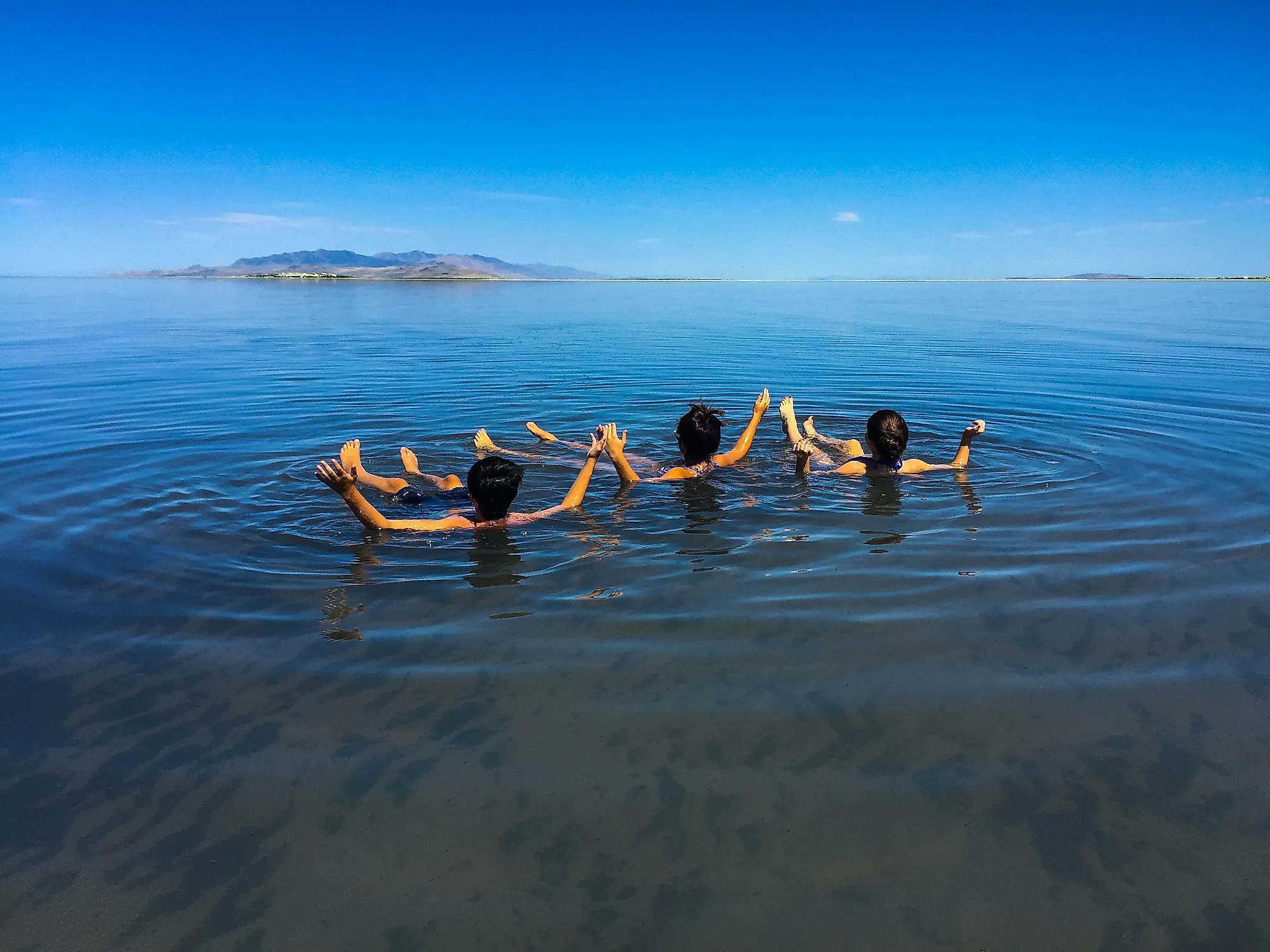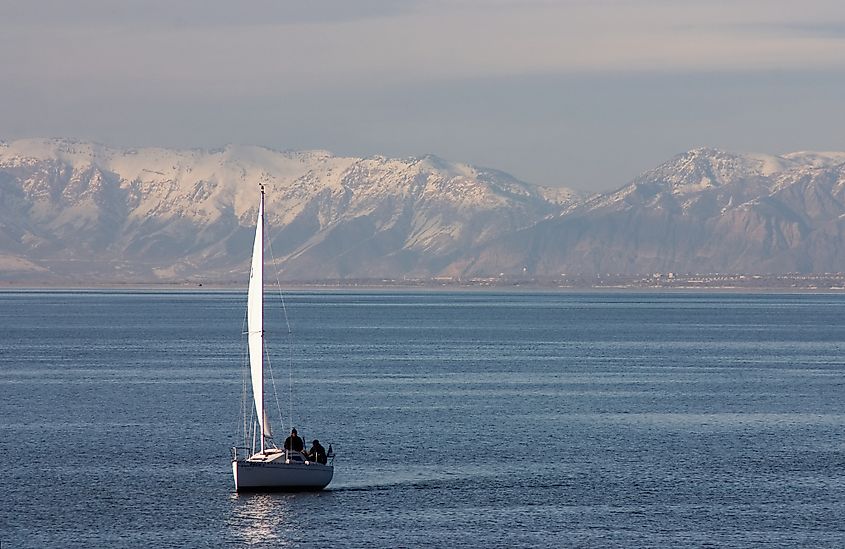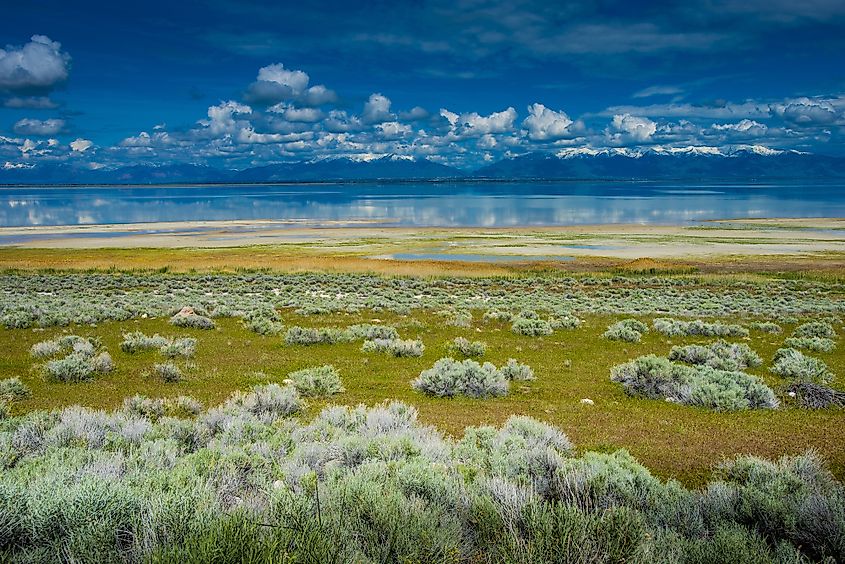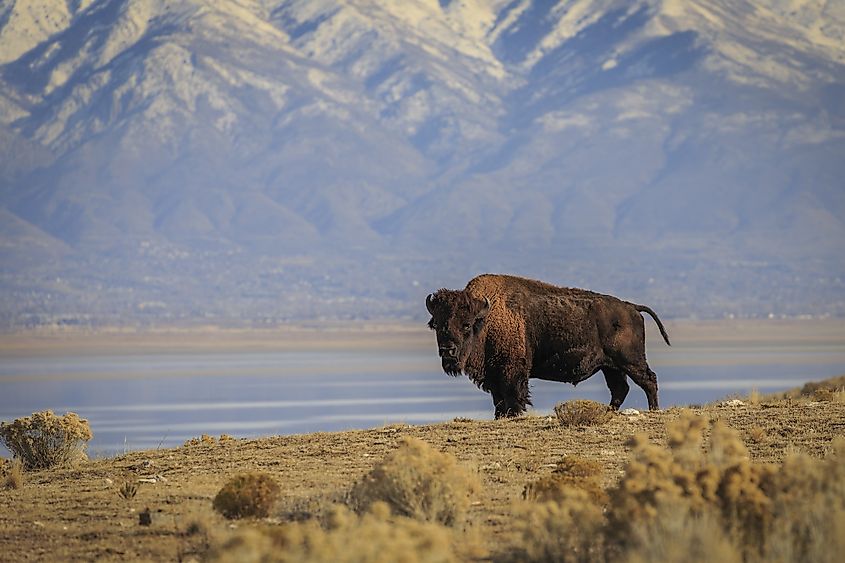
Great Salt Lake
Covering an area of approximately 4,400 sq. km, the Great Salt Lake is the world’s eighth-largest terminal lake and the largest saltwater lake in the Western Hemisphere. This large saltwater lake is situated in the northern part of the US State of Utah. Often referred to as America’s Dead Sea, the Great Salt Lake serves as a critically important habitat for numerous resident and migratory birds in addition to several types of brine shrimps, algae, and brine flies. The Great Salt Lake serves as one of the largest and most popular tourist destinations in Utah, offering a wide range of recreational activities for its visitors and contributing about $1.3 billion to the state’s economy.
Geography Of The Great Salt Lake

The Great Salt Lake is situated partly within five counties of Utah, namely, Salt Lake County, Tooele County, Box Elder County, Davis County, and Weber County. The lake gave its name to Salt Lake City – the state’s capital and its most populous city, which was initially named “Great Salt Lake City” by Brigham Young, an American religious leader who served as the second president of The Church of Jesus Christ of Latter-day Saints. The Great Salt Lake is surrounded by Salt Lake City and its suburbs in the eastern and southeastern sides located between the Great Salt Lake and the foothills of the Wasatch Mountains. The lake is also surrounded by the Stansbury Mountains and the Oquirrh Mountains in the south; and the Bonneville Salt Flats – a part of the Great Salt Lake Desert in the west. The area around the northern and western shores of the Great Salt Lake is more or less uninhabited.
The Great Salt Lake is fed by three principal rivers and numerous small streams. The three main rivers receive their waters mainly from the Uinta Mountains, located in the northeastern part of the state. The Bear and the Weber Rivers begin from the northern slope of the Uinta Mountains, while the Jordan River starts from the Utah Lake that is in turn fed by the Provo River that originates from the Uinta Mountains. It is estimated that together these three major tributaries of the Great Salt Lake deposit more than 1.1 million tons of minerals in the lake annually. Studies have revealed that the total dissolved mineral accumulation in the lake basin is about 5 billion tons, with minerals like magnesium, sodium, potassium, chloride, and sulfate present in large quantities. Since the lake has no outlet, it mainly loses water naturally by evaporation. The accumulated minerals result in the high salinity and density of the Great Salt Lake.

The Great Salt Lake has a length of 120km and a maximum width of 45km. The lake reaches an average depth of 4.9m and a maximum depth of 10m. The surface area of the Great Salt Lake dramatically varies depending on the evaporation rates and the flow of the principal rivers that feed it. Records indicate that the lake’s surface area had changed from 6,200 sq. km at its highest level in 1863 to 2,460 sq. km at its lowest level in 1963. At high levels, the lake is located at an elevation of 1,284m above sea level, while at lower levels, the lake is at the height of 1,277m. The Great Salt Lake has a water volume of 18.92 cubic kilometers and a catchment area of 55,685 sq. km.
There are many islands in the Great Salt Lake, although their exact number varies depending upon the method used to determine the constitution of an island. As the lake’s water level significantly varies, what is considered an island in the dry season could also be considered a peninsula in the next season. As per the Utah Geological Survey, there are currently ten islands in the Great Salt Lake, including Antelope Island, Badger Island, Carrington Island, Cub Island, Dolphin Island, Fremont Island, Stansbury Island, etc., as well as many rocks, shoals, or reefs like Gunnison Island, Strongs Knob, Goose, Browns, Black Rock, Egg Island, etc.
The varying shoreline of the Great Salt Lake features several beaches, marshes, and mudflats. The Lucin Cutoff is a 164km long railroad line that links the cities of Lucin and Ogden and runs across the Great Salt Lake. As a result, due to the obstruction of the water flow and regular mixing of the waters by this earthen causeway, the Great Salt Lake appears to be of different colors: the northern part seems brown while the southern part seems to be green in color. The Great Salt Lake also dramatically affects the climate of the surrounding region, mainly through the lake-effect snowfalls. It is estimated that about 6 to 8 lake-effect snowfalls take place in a year, and about 10% of the average precipitation of Salt Lake City is due to this lake effect.
Origin Of The Great Salt Lake
The Great Salt Lake is believed to be a remnant of Lake Bonneville - the most significant prehistoric pluvial lake, formed about 30,000 years ago during the Pleistocene Epoch, located in the Great Basin in the western portion of the North American continent. This prehistoric lake had an estimated area of about 58,000 sq. km and covered significant parts of the present-day states of Utah and small portions of Idaho and Nevada. The prehistoric lake reached a maximum depth of 281m at its deepest point and had approximately ten times the size of the present-day Great Salt Lake. It is believed that about 16,800 years ago, a large part of Lake Bonneville was released through Idaho’s Red Rock Pass and resulted in catastrophic floods. As the climate became relatively warmer after the Ice Age, the remaining portion of Lake Bonneville began to dry and leave behind several lakes like Utah Lake, Sevier Lake, Rush Lake, and the Great Salt Lake.
Ecology Of The Great Salt Lake

The high salt content of the Great Salt Lake makes the waters of the lake unusually dense and habitable for a very few species, including several forms of algae, brine shrimp, and brine flies. It is estimated that there are more than 100 billion brine flies in the Great Salt Lake that serve as the primary food source for the numerous avian species that visit the lake. The fresh and saltwater wetlands located in the eastern and northern parts of the lake also provide vital habitats for the numerous migratory shorebirds and waterfowls.
Some notable avian species that are found here include American avocet, Wilson’s phalarope, California gull, black-necked stilt, American white pelican, peregrine falcon, marbled godwit, etc. Many islands in the lake also serve as critical nesting areas for many birds and provide vital habitats for various plant species, lizards, and other small mammals. In addition to this, located on the shores of the Great Salt Lake are about 27 private duck clubs, seven state waterfowl management areas, and a large federal bird refuge. Due to its high salinity, the Great Salt Lake contains very few fish species. However, a few aquatic animals are found in the central basin of the Great Salt Lake.

Brief History
It is believed that the area surrounding the Great Salt Lake was inhabited by the indigenous Ute tribes, Southern Paiute people, and the Shoshone tribes for thousands of years. The Western Goshute tribe referred to the lake as “Ti’tsa-pa,” which meant “bad water,” and as “Pi’a-pa,” which meant “big water.” In 1776, the Spanish explorer Silvestre Velez de Escalante learned about this large lake from the native Timpanogos Utes. Based on the Indian tales and the reports of the explorer-trappers, the lake appeared on the 18th-century maps and was alternately named Timpanogos or Buenaventura. In 1824, the lake was independently observed by the American mountain man James Felix Bridger and the French Canadian fur trader Etienne Provost. Captain John C. Fremont made the first scientific expedition to the lake in 1843. In 1847, the Mormons settled in the nearby Salt Lake City and brought the entire region into national awareness. In 1850, the lake was fully surveyed, and in 1869, the first transcontinental railroad began to operate close to the northeastern shores of the Great Salt Lake.











